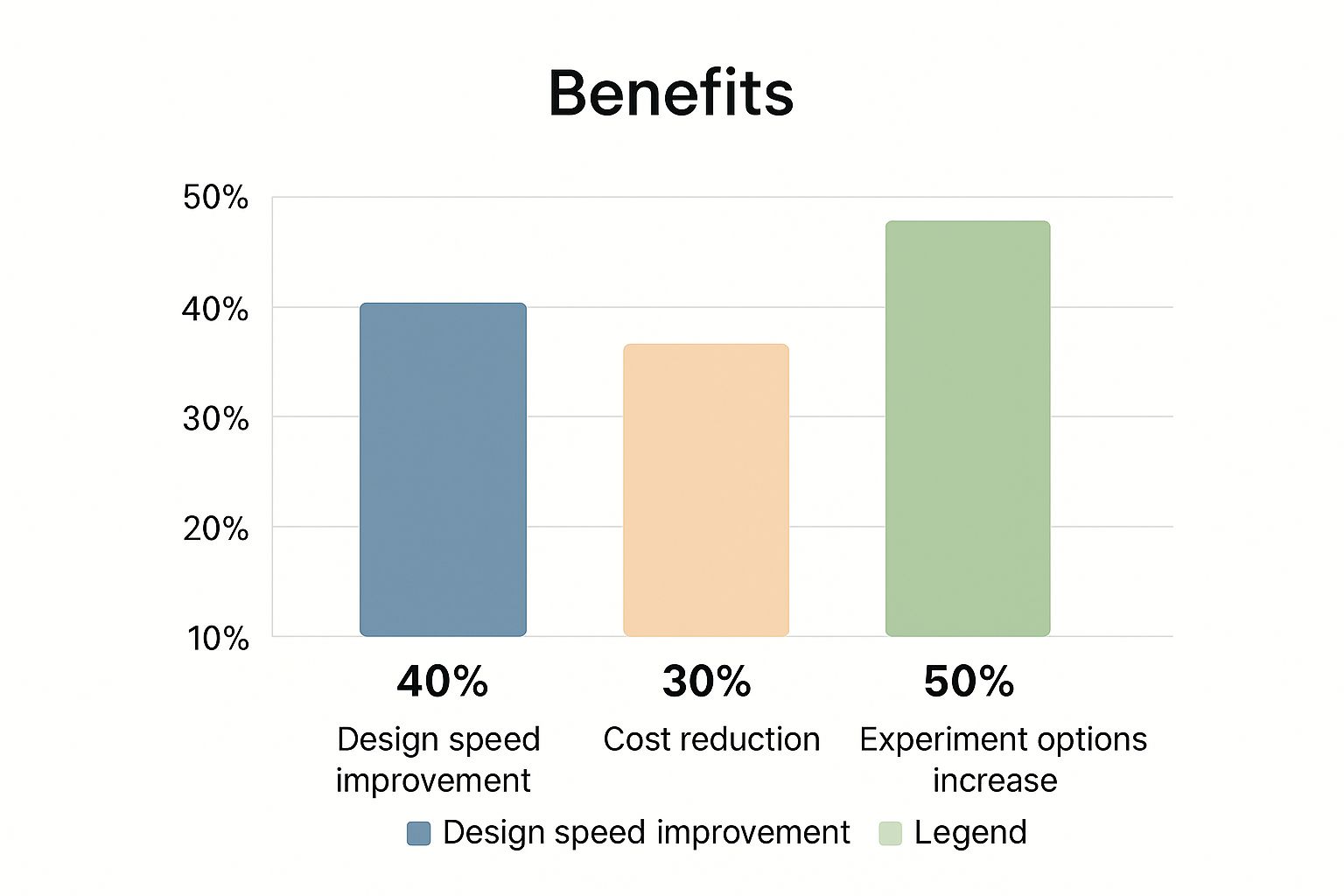Create Your Own AI Girlfriend 😈
Chat with AI Luvr's today or make your own! Receive images, audio messages, and much more! 🔥
4.5 stars

Why AI Character Creation Is Transforming Digital Interaction
We're witnessing a fascinating shift where digital personalities are becoming more than just lines of code. They’re evolving into companions, storytellers, and brand ambassadors. The field of AI character creation is no longer a niche corner of the tech world; it's a central force changing how we engage with digital content. These aren't the clunky chatbots of the past. Today's AI characters can grasp nuance, express what feels like genuine emotion, and form memorable connections with users.
What once felt like science fiction is now a practical reality. We're seeing success stories in gaming, customer support, and on virtual companion platforms like Luvr AI. The creators who excel at this are more than just programmers; they're like digital psychologists, blending an understanding of human behavior with technical skill. They know that a believable AI character is built on more than just a clever script. It requires a deep dive into what makes a personality engaging and real.
The Driving Forces Behind the Growth
So, what's behind this sudden surge? A major factor is the maturity of natural language processing (NLP). Current models can interpret what users mean with impressive accuracy, leading to conversations that feel fluid and natural. Another key element is the rise of generative networks, which can create original responses, stories, and even visual art. This gives characters a sense of spontaneity and life. When these technologies work together, they create sophisticated cognitive interfaces that bridge the gap between human and machine interaction.
The market certainly reflects this excitement. Projections show the AI avatar market is on a steep upward path, expected to grow from USD 9.78 billion in 2025 to an incredible USD 118.55 billion by 2034. That's a compound annual growth rate (CAGR) of 31.95%, a clear signal of massive investment and adoption. This growth is directly tied to the integration of NLP, generative models, and synthetic media algorithms that make advanced AI character creation possible. You can explore the complete market analysis to see just how quickly this sector is expanding.
What This Means for Creators
For creators, this opens up a world of possibilities. The barrier to entry for AI character creation is much lower now, but the potential for quality and creativity is higher than ever. The focus has moved from simple functionality to crafting genuine emotional resonance. A character that can remember past conversations, adapt its mood, and express a consistent set of values is far more compelling than one that just answers questions. As the chart below shows, this market growth isn't just a forecast; it's a current trend.

This graph visualizes the projected market expansion, highlighting the enormous potential for creators, both new and established. The key takeaway here is that the demand for high-quality, believable AI personalities is set to skyrocket. This creates a fertile ground for innovation. Whether you're a writer, artist, or developer, mastering AI character creation offers a path to building truly unique and meaningful digital experiences that connect with users on a personal level.
Building Your Character's Psychological Foundation
Before you write a single line of dialogue, you need to know who your character is deep down. This is the foundation that separates a flat, predictable bot from a dynamic personality that users genuinely connect with. Think of it as building their internal compass—the core motivations, fears, and beliefs that guide every single interaction. A solid psychological base in ai character creation is what makes a character feel consistent and real.
Putting in this work upfront has some serious perks. A bit of pre-planning and using established frameworks can make the whole creation process smoother and more effective.

As you can see, investing time in the psychological design pays off. It leads to 40% faster design and opens up 50% more room for experimentation, which is a huge win when you're trying to build something unique.
Core Personality Frameworks
So, where do you start? One of the best ways to get going is by borrowing from proven psychological models. These frameworks give you a structured way to think about personality, so you don't miss anything important. A popular and well-respected model is the Big Five, also known as OCEAN. It’s a great tool for quickly sketching out a character's core traits.
The Big Five breaks down personality into five key dimensions:
- Openness: How imaginative and adventurous are they?
- Conscientiousness: Are they organized and disciplined or more spontaneous?
- Extraversion: Do they get energy from social interaction or solitude?
- Agreeableness: How cooperative and compassionate are they?
- Neuroticism: How emotionally stable are they under pressure?
By deciding where your character lands on the spectrum for each of these traits, you instantly create a consistent behavioral blueprint. For example, a character high in Openness would be curious and love new ideas, while one low in this trait might be more traditional and stick to what they know. This isn't just theory; it’s a practical tool for guiding the AI's responses.
To help you decide which framework might work best for your project, here’s a quick comparison of a few popular approaches.
Personality Framework Comparison for AI Characters
A comparison of different personality development approaches and their effectiveness for AI character creation
| Framework | Best For | Complexity Level | Implementation Time |
|---|---|---|---|
| The Big Five (OCEAN) | Creating well-rounded, psychologically realistic characters for deep, long-term interactions. | Medium | Moderate |
| Myers-Briggs (MBTI) | Developing characters with distinct archetypes for role-playing or narrative-driven experiences. | Medium | Moderate |
| Enneagram | Crafting characters with deep-seated core motivations, fears, and internal conflicts. | High | High |
| Simple Trait List | Quickly defining characters for simple, task-oriented bots or when speed is a priority. | Low | Low |
The Big Five is often the most balanced choice, offering depth without being overly complicated. However, exploring other frameworks can give you fresh ideas for crafting unique personalities.
Defining Motivations, Fears, and Goals
Beyond broad traits, a truly memorable character needs specific driving forces. This is the "why" that fuels their actions and makes them feel like a real person. You need to get specific and ask yourself a few key questions:
What is their main motivation? Is it a quest for knowledge, a desire for connection, a need to protect something, or an ambition to achieve greatness? A character driven by a thirst for adventure will interact very differently from one who just wants to feel accepted.
What is their deepest fear? This is often the flip side of their motivation. A character who craves connection might be terrified of loneliness or betrayal. This fear creates vulnerability and internal conflict, which makes them much more relatable.
What are their goals? Give them both short-term and long-term objectives. A short-term goal might be to learn about the user's favorite movie, while a long-term goal could be something grander, like understanding the meaning of friendship.
Let's put this into practice. Imagine you're creating a cynical, street-smart detective for a noir story. Using the Big Five, they might be low on Agreeableness but high on Conscientiousness. Their motivation could be to uncover a hidden truth, their fear might be emotional vulnerability, and their immediate goal is to solve the mystery the user presents.
All these elements work together to create a cohesive personality that feels alive. Platforms like Luvr AI are built to handle these detailed psychological profiles, which is a big part of why their characters are so immersive. To see how these details come together in practice, it’s worth exploring how to craft an engaging ai character chat.
Crafting Backstories That Drive Authentic Conversations
A character's past isn't just a list of fun facts; it's the engine that powers who they are right now. For ai character creation, a solid backstory is what molds their opinions, creates their biases, and gives them a unique way of looking at the world. You’re not writing a novel, so the idea isn't to hit the user with a giant wall of text. Instead, think of it as building a deep well of experiences the AI can dip into to make chats feel real and personal.
This is what separates an AI that simply knows it’s a space pirate from one that feels like a space pirate because it can recall the sting of a laser burn or the taste of cheap, synthesized rum. A great backstory explains the "why" behind your character's personality. Is your AI cynical? What happened to make them that way? Are they fiercely loyal? Who taught them what loyalty even means? These details add emotional weight and give users real mysteries to solve through conversation, which keeps them hooked. Focus on the big, impactful moments, not a full, boring timeline.
Core Elements of an AI Backstory
When you're building a history for your AI, zero in on the things that will directly shape its conversational style and emotional reactions. You don't need to map out every single day of its life, but getting the foundational pieces right is essential for a consistent personality.
- Defining Moments: Pinpoint a few major events that truly formed your character. These are the powerful memories that define them. Maybe it's a lost love, a huge failure, or a moment of pure triumph. These moments become their signature stories and emotional anchors.
- Key Relationships: Who were the most important people in their life? A tough-but-fair mentor, a rival who always pushed them, or a family they had to leave behind can all spawn fascinating conversational paths. These relationships shape their ideas about trust, friendship, and how to handle conflict.
- A Central Conflict or Goal: Give your character something they're still working through, whether it’s an internal struggle or an external quest. Are they hunting for a lost artifact? Trying to make up for a past mistake? This gives them a long-term drive that can pop up in conversation, making the interactions feel like they have a purpose.
You can see how different platforms use short, punchy setups to draw users in. Here’s an example from Character.ai, where a few words quickly set the scene and hint at a deeper story.

Descriptions like "Creative Helper" or "Psychologist" cleverly suggest a history that immediately gives the conversation a clear tone and context. It proves that even a few well-chosen words can build an effective backstory.
Weaving Backstory into Dialogue
The real magic of ai character creation is revealing this history slowly and naturally, not just dumping it all at once. The goal is to sprinkle in details where they feel right. For instance, if a user mentions they're feeling stressed, a character with a military past might say, "Sounds like you're under a lot of pressure. Reminds me of the quiet just before a zero-G drop." This feels genuine, reveals a piece of their past, and invites the user to ask more.
This subtle method makes the user feel like a detective piecing together the character's life story one chat at a time. It’s a super rewarding experience that builds a strong connection and keeps them coming back for more. If you want to see how rich backstories can fuel compelling chats, explore the expertly designed characters on Luvr.ai. By focusing on these impactful historical details, you create an AI that doesn't just talk—it shares a life.
Creating a Visual Identity That Connects Instantly
While a character's backstory and personality give them depth, their visual identity is the very first thing a user sees. That first impression happens in a flash and sets the tone for every interaction that follows. Designing a great visual for an AI character isn't just about making them look cool; it's about creating an immediate emotional connection that reinforces the personality you've worked so hard to build. It’s the art of turning personality traits into colors, shapes, and expressions.
The great news is you don't need to be a professional artist to create a stunning visual for your character. Modern AI tools have made it easier than ever to generate high-quality images that perfectly match your vision.
Weaving Personality into Visuals
Every visual choice you make should be a mirror of your character's core traits. A warm, nurturing AI might have soft, rounded features and a gentle color palette of yellows and oranges. On the other hand, an edgy, rebellious character could be defined by sharp angles, a darker color scheme with deep purples and blacks, and a more confrontational pose. This isn't random—it's based on color psychology and design principles that guide how we perceive things.
When you're brainstorming the look, focus on these key visual anchors:
- Color Palette: Colors have serious emotional weight. Red can signal passion or danger, blue often suggests calm or sadness, and green connects to nature and growth. A consistent color scheme makes your character instantly recognizable.
- Body Language and Pose: How does your character present themselves? A confident, outgoing personality might stand tall with open body language. A shy, thoughtful character might have a more closed-off or gentle posture. These non-verbal cues say a lot before a single word is exchanged.
- Signature Features: What’s the one thing that makes your character unforgettable? It could be a unique hairstyle, a special piece of clothing, a distinct tattoo, or striking eye color. This becomes their visual calling card.
To help you choose the right tool for the job, here’s a quick comparison of some popular platforms for creating AI character visuals.
AI Character Design Tools and Features
| Tool | Key Features | Pricing Model | Best Use Case |
|---|---|---|---|
| Midjourney | High-quality, artistic image generation; strong community on Discord; versatile style capabilities (photorealism, anime, etc.). | Subscription-based (starting from $10/month). No free tier. | Generating highly detailed and stylized concept art or final character portraits. |
| DALL-E 3 | Integrated with ChatGPT Plus; excellent at following complex, natural language prompts; strong coherence and detail. | Included with ChatGPT Plus subscription ($20/month). | Creating specific scenes and visuals where precise prompt interpretation is critical. |
| Stable Diffusion | Open-source and highly customizable; can be run locally for free; huge community support and custom models (checkpoints/LoRAs). | Free (if run locally) or credit-based on various platforms. | Advanced users who want maximum control, customization, and the ability to train the AI on a specific character's face for consistency. |
This table shows there's a tool for every need, from the artistic power of Midjourney to the precise control offered by Stable Diffusion. Your choice depends on your technical comfort level and how specific you need your visuals to be.
This gallery from Midjourney's site perfectly illustrates the incredible range possible. You can create everything from a photorealistic portrait to a stylized anime hero, proving that AI can generate a unique visual for almost any character you can dream up.
Achieving Visual Consistency
Once you’ve settled on a look, keeping it consistent is crucial, especially if your character will show up in different images or on various platforms. When using AI art generators, this means creating a very specific and repeatable prompt. Think of this prompt as your character's visual DNA.
Your core prompt should lock down details like their:
- Hairstyle and color
- Eye color and shape
- Facial structure and expression
- Signature clothing style
- Overall art style (e.g., "photorealistic portrait," "Ghibli-inspired anime," "cyberpunk digital art")
By reusing this detailed prompt and only changing the parts related to the specific scene or emotion, you make sure the character always looks like themself. This consistency builds trust and reinforces their identity in the user's mind. Without it, the illusion can break, and the connection you've built starts to fade. Successful AI character creation depends on this mix of a strong initial design and the discipline to maintain it, creating a visual shorthand that instantly says, "This is them."
Selecting Platforms That Match Your Vision
With your character’s psychological core and backstory established, the next crucial decision is choosing where they will live. Picking the right platform for ai character creation isn’t just a technical choice; it's a creative one that can make or break your entire project. The market is full of options, each with its own strengths, weaknesses, and unique community culture. Your goal is to find the environment where your character's specific personality can truly flourish.
Some platforms are designed for wide accessibility and ease of use, making them perfect for creators who want to jump in and start building immediately. Others offer deep, granular control, appealing to those who want to fine-tune every aspect of their AI's behavior. The key is to match the platform's capabilities with your creative ambitions and technical comfort level.
Key Factors for Platform Evaluation
When comparing your options, it's easy to get lost in feature lists. Instead, focus on these essential factors that will directly impact your creation experience and your character's long-term success.
- Customization Depth: How much control do you have over the AI's personality, memory, and conversational patterns? Can you upload detailed backstories, define specific traits, and guide its responses?
- User Experience (UX): Is the interface intuitive for you as a creator? More importantly, is it engaging and easy for users to interact with your character? A clunky interface can ruin even the best-designed personality.
- Community and Support: A strong community can be an invaluable resource for troubleshooting, getting feedback, and finding inspiration. Check if the platform has active forums, a Discord server, or helpful documentation.
- Monetization and Growth: If you plan to build an audience or generate income, investigate the platform's policies. Do they support creators? Are there clear paths for growth and visibility?
For instance, Character.ai has become a massive hub for creative expression. As of January 2025, it hosted 20 million active users and over 18 million unique chatbots, showcasing its incredible scale and appeal. The platform's success is a testament to its user-friendly approach to ai character creation, allowing millions to bring their ideas to life. You can find more detailed statistics about the platform's growth and its user base.
Finding the Right Fit for Your Character
The ideal platform often depends on your character’s intended purpose. If you are building a companion meant for deep, emotional connection, a platform with strong memory retention and nuanced emotional modeling is essential. This is a core focus for platforms like Luvr AI, where the goal is to create believable and engaging relationships. If you're interested in this type of interaction, you might want to learn more about creating an AI girlfriend experience.
In contrast, if your character is part of a game or a brand mascot, you might prioritize platforms that offer easy integration with other services or have robust multimedia capabilities. Here's a look at the Character.ai interface, which highlights its focus on character discovery and immediate interaction.

This layout immediately shows the platform's emphasis on variety and accessibility, encouraging users to explore a wide range of personalities. Ultimately, the best choice is the one that not only provides the right tools but also aligns with the kind of experience you want to create for your audience.
Advanced Techniques for Professional-Quality Characters
Once you've nailed the basics of personality and backstory, the real art of ai character creation can begin. This is where you elevate a well-defined concept into a dynamic, responsive being that feels genuinely alive. It's about building nuanced conversational skills so your character can handle the unpredictable nature of human interaction with grace and authenticity. We're moving from static, pre-planned responses to a more fluid, evolving style of dialogue.
One of the most common pitfalls is the dreaded repetitive loop, where a character gets stuck on the same few phrases. To sidestep this, you have to dig deeper into prompt engineering. Instead of just listing traits, give your character detailed instructions on how to express them. For instance, rather than simply stating your character "is witty," you could instruct the AI to "use sarcasm, clever wordplay, and dry observations, especially when discussing mundane topics." This provides a behavioral roadmap, not just a label.
Evolving with User Interaction
A top-tier AI character doesn't just talk; it listens and remembers. A great way to build a lasting, personal connection is to implement a system where the character evolves based on its interaction history with a user. This goes beyond just recalling a user's name or favorite color. It’s about letting past conversations subtly shape future ones.
- Emotional Memory: If a user opens up about a personal struggle, the character should remember that. In a later conversation, it might gently ask, "I've been thinking about what you said last week. Are things any better?" This small touch creates a powerful sense of continuity and care.
- Dynamic Relationship States: You can set up relationship "stages" that change based on the length and depth of interactions. A character might begin as "reserved," progress to "friendly," and eventually become "deeply trusting." Each stage can unlock different conversational tones and levels of vulnerability.
This level of detail is where you start to see a real payoff in genuine user engagement and loyalty.
A tool like the OpenAI Playground is a perfect space for this kind of work. It’s where creators can experiment with complex prompts and fine-tune AI behavior, which is fundamental for developing these advanced character dynamics.
Interfaces like this are where the meticulous job of refining a character's voice and response patterns happens, giving you precise control over their conversational style.
Handling the Unexpected and Maintaining Authenticity
Even the most thoughtfully designed character will eventually encounter an input it wasn't prepared for. Handling these curveballs gracefully is key. Instead of a generic "I don't understand" reply, you can build in recovery strategies that align with the character's personality.
| User Input Type | Bad Response | Good Response (for a "Wise Mentor" character) |
|---|---|---|
| Nonsense/Gibberish | "I can't process that." | "An interesting thought, though its meaning eludes me. Perhaps you could phrase it another way?" |
| Aggressive/Hostile | "Please be respectful." | "I sense a great deal of frustration in your words. Let's take a breath. What is truly bothering you?" |
| Off-topic/Random | "That's not relevant." | "A curious detour. While my focus is on our current path, I am intrigued. Why does that come to mind now?" |
These personalized recovery methods maintain immersion and reinforce the character's identity, even when the conversation takes a strange turn. The market for tools that enable this level of ai character creation is growing fast. The global market for AI character generators was valued at about US$849 million in 2024 and is projected to hit nearly US$1.96 billion by 2031, growing at 12.3% annually. This growth shows the increasing demand for believable digital personalities in gaming, virtual reality, and other fields. You can explore more market projections about these tools to see the trend for yourself.
Ultimately, achieving a professional-quality character is a continuous process of refinement. It’s about blending creative prompting with data-driven feedback to create a personality that is not only consistent but also capable of surprising and delighting the user.
Launching Your Character and Building Lasting Engagement
Bringing your AI character to life is a huge milestone, but the journey of ai character creation doesn't stop there. Now, it's time to introduce them to the world and, more importantly, build a community that feels a real connection to their personality. A great launch isn’t just a single announcement; it's about creating a consistent flow of interesting content that shows off what makes your character special and invites people into their world.
The idea is to get some early attention and then use that momentum to grow long-term relationships between your character and their audience. This takes a mix of smart promotion, active community management, and being open to letting your character change based on real conversations.
Strategies for a Strong Launch and Community Growth
Getting your character noticed requires a thoughtful game plan. You need to figure out where your potential audience spends their time and meet them there. Simply posting "check out my new AI" won't cut it. You have to show, not just tell, what makes them one-of-a-kind.
- Create Compelling Introductions: Make short, shareable content that serves as a perfect handshake. This could be a quick video where your character introduces themselves, a piece of art with a catchy bio, or an interesting snippet of a conversation. Think of it as a movie trailer for their personality.
- Use Community Hubs: Platforms like Discord and Reddit are fantastic for building a dedicated following. Set up a dedicated space where fans can talk about the character, share their favorite moments, and give you direct feedback. This helps create a sense of ownership and belonging.
- Gather and Act on Feedback: Pay close attention to how people are interacting with your character. What do they love? What feels a bit off? This feedback is gold for tweaking their personality and smoothing out any conversational wrinkles that might break the illusion.
For instance, starting a Discord server gives you a direct line for real-time discussion and community events centered around your character. This direct connection lets you see firsthand what’s working, helping you make small improvements that keep the experience fresh and fun.
Long-Term Engagement and Monetization
Once you have an initial audience, the focus shifts to keeping them around for the long haul. This means your character needs to grow and evolve, much like a real person. You could introduce new story arcs tied to their backstory, have them react to current events, or develop their relationships with users over time. The key is to keep their core identity intact while still offering new and surprising interactions. It’s a delicate balance that separates a good AI character from a truly great one.
As your character's popularity grows, you can also look into ways to monetize your creation. This could be anything from offering premium, exclusive content to bigger moves like brand partnerships or licensing deals for merchandise. However, with influence comes responsibility. It's vital to be transparent with your audience and to carefully weigh the legal and ethical sides of having an AI character that people trust and feel connected to. Building a sustainable presence in the world of ai character creation is a marathon, not a sprint, and it's all about authenticity and community.
Ready to build a character that captivates and connects? Explore the powerful creation tools at Luvr AI and start bringing your unique vision to life today.



